“Everyone keeps saying about us, “Oh, look at the foreign journalists,†Sercin tells me gleefully as we squeeze between the flapping Turkish flags and yet another portrait of Mustafa Kemal Ataturk, revered founder of the country. This one is behind glass in a wooden frame, as if it had been hastily dehooked from the living room wall.
It’s Sunday, April 29, and Sercin and I are at Istanbul’s Caglayan Square. (Caglayan, like many Turkish proper nouns, has several accent marks that I’m not capable of typing in. Just for the record.) It’s of those beautiful cusp days in spring that confuses the skin—it tingles in the sun and gets goosebumpy in the shadows.
Sercin, a medical translator here in Istanbul, looks the part of photojournalist better than I do, with her olive green femme flak jacket, skinny mauve scarf, and jeans. (I have the jeans, but somehow my jacket is too soft, too afternoon brunch, and it doesn’t have the requisite number of pockets for all those film canisters we don’t use anymore, having gone digital.) She’s just finished a photography course and has a brand-new Canon she’s both eager and nervous to use.
Though new to the camera, she’s old to charming the pants off people. She fearlessly closes in on her subjects without making them feel uncomfortable. It’s something I’m still too timid to be good at.
Perhaps as many as a million people are protesting the current elections for the second time in as many weeks. (The first rally was in Ankara, the capital, and at least three more will follow in other cities in the month after.) It’s a complicated situation that becomes even more confusing, at least for this American, because of the nuances of parliamentary democracy and Turkish electoral law, which even the Turkish high court is confused about.
But at the heart of the debate is a simple question of identity (alas, without a simple answer): What does a Turk look like?
*******
It seems that for these protestors, Turkey is unveiled—even though some of the protestors themselves are.
The leading presidential candidate—the only presidential candidate—up for election before the Turkish Parliament is the current foreign minister, Abdullah Gul. He’s from the party that controls parliament, and is considered a former Islamist. Gul’s wife wears a head scarf, which sets up on interesting conundrum, as head scarves are banned in government offices.
Some, but by no means all, Turks are suspicious of how much Gul would incorporate sharia, or Islamic law, into Turkish law. Turkey has been staunchly secular since its creation in 1922. In a sort of reactionary twist, the military has been secularism’s guardian. Like its warrior breathren the world over, the Turkish military ain’t subtle: there have been four coups over the years. The last time was in 1997, when the military forced the breakup the Islamist-bent Welfare Party, which Gul was a member of. Now, with Gul’s election on the horizon, the military has been making noises that it might interfere once more.
The protestors seem disgusted with both the veil and the mil. They argue that both religious fundamentalism and military usurpation of the democratic process are equally at odds with a modern Turkey.
This is all on my mind as we wander through the protest. Despite seriousness of the issues, the atmosphere is quite jovial, with lots of laughter, music, and poetry (Communist poetry, apparently). Sercin keeps laughing at the wit and humor of the chants. She does her best to translate them for me. There’s one that puns on imam bayildi, a sort of dessert pudding. [Note: Sercin wrote in to say that imam bayildi is not a dessert, but a main course. Ack. I should’ve double-checked my source.] Imam bayildi means “fainting imam” in Turkish.
“Now they’re saying that for the imam to faint isn’t good enough, ” she says, delighted. “He should be dead! Ha!”
This strikes me as a bit bloodthirsty, especially as it relates to a mild-mannered dessert.
Around us stream people and their flags. The crescent and star wave from poles, drape across people’s shoulders, are patched on baseball caps. From beneath his quintessential fez, Ataturk looks out on pins, shirts, posters.
An enormous balloon bobs overhead like a strange sky luer. Beyond the balloon is a broadcast tower, a metal spindle probably beaming the sight of this protest all over the world. People are staring at it as if they might see themselves on TV.
But that’s not it, actually. “There’s a man up there!” Sercin yelps, pointing. His whole body sways as he waves extravagantly at the hundreds of thousands below him. No one waves back.
He has no safety attachments, no ladder, no sanity. Is this patriotic fervor or jumper madness? Or both?
Back on the ground, we pass a woman holding above her head a sign on which she has drawn a lightbulb, the symbol of Gul’s party. Among the Turkish words, the word “Edison” jumps out.
Sercin notices it at the same time and grins. “It says that Edison would be sorry if he knew what happened to his lightbulb.”
*******
“How do they know I’m a foreigner?†I ask Sercin as we pardonne our way through the crowd. Since arriving in Istanbul, I’ve felt incredibly comfortable, like I fit right in somehow. Just another face in the crowd. It’s been a relief after three months of being so noticably different from everyone.
She looks at me as if I’ve just asked to kiss Ataturk. “You don’t look Turkish.â€
“Well, I know that,†I say, sheepishly. “But when I look around, everyone looks so different from one another. I don’t look like them, but they don’t look like each other, either. Turks don’t look like any one thing.â€
Black hair. Blond hair. Blue eyes. Brown eyes. Tall and leggy. Short and squat. Patrician noses, nub noses. Hair uncovered, hair covered. The list goes on and on of all the ways Turks—at least ones in Istanbul, around which half of the Turkish population lives—don’t look like each other.
More than anywhere I’ve been, here faces reflect history. I won’t attempt to cover the enormous length and complexity of Turkish history when Wikipedia has the basics, but suffice it to say that as the crossroads of Asia and Europe, a large percentage of humanity, for a huge span of history, has been born in, come through, or settled down in Turkey. They’ve all left their mark on the landscape. Turkey is covered with an amazing array of ruins: Neolithic settlements like Catalhoyuk; the fortified Bronze Age city of Troy; the Greek settlement of Ephesus; the Lycian-Roman ampitheaters of the Mediterranean Coast; the gilded glory of Byzantine Istanbul; Ottoman mosques with their minarets needling the clouds. The list goes on and on.
With this sort of history, the question of what a modern Turk looks like is a complicated one. How do you establish a “national face” in a place whose history is a testament to both the diversity and unity of the human race—current national borders be damned?
So how does everybody know I’m a foreigner? After all, I’m eastern European. Russia and Ukraine are north, directly across the Black Sea. Poland borders Ukraine. There are plenty of transplants from these regions living in Istanbul.
It’s not the eyes, Sercin says as we slowly work our way towards the edges of the rally. It’s time to go. For hours, we’ve been shooting the red Turkish flag against the creamy blue sky—if gelato came in the flavor of sky, it would be this color and consistency—and we’ve exhausted its potential. The viewfinder on my camera shows that I have captured too many backs, too many tops of heads, too much flapping red fabric.
Nor is it the freckles or even the red hair, which she knows I get from a bottle. The upturned nose is unheard of on Turkish faces, she says, but still—the nose isn’t it either.
“There’s an individuality to Westerners,” she says. “I can see you are an individual in your face.” Her quarter-size hazel eyes scan me from hairline to chin. “There is a self-confidence. A way you move that says you don’t care what people think.”
Turks, she says, are curtailed by their obligations to family and culture and country and family. “In Turkey, we always have our families on our faces.”
I feel irrationally defensive, as if she’s just accused me of being indifferent to my family and culture. My upturned nose suddenly seems like the leaping-off point to the very heights of American self-involvement. I admit to Sercin that even for an American, I am fiercely resistent to joining a tribe, whether it’s national, corporate, ideological—or even geographic, roaming the world as I am. But that doesn’t mean I am completely disloyal.
“Here I am without context,” I protest. “In America you could see me with friends, family, my home, my city, my work—all the things that place me in the world, that I feel a responsibility to.”
“It’s not that,” she counters. “I’ve been to America. I’ve been to European countries. And it’s the same.”
I try to puzzle out what she means, and if I’ve seen it myself. “Americans have a big presence,” I suggest. “I can usually tell Americans from Europeans not only by the way they dress, but by how big they are,” I continue. “They take up a lot of space.”
Her eyes widen with recognition. “Yeah, yeah!”
I’m suddenly compelled to confess something I haven’t told many people, because I’m afraid I sound crazy. But I tell her anyway. More than two months before in China, one night I was hit by the strongest sense of disembodiment I’ve ever experienced. I was on my way to dinner in Lijiang when an overwhelming sense of unreality crashed into me. It was as if the veil had been lifted. I held my hands out and looked them. This is me? I thought. I watched, detached, as my hands began to shake. They looked familiar, sure: the ragged nails, the long knuckles, the increasingly prominent veins, the wrists going carpal tunnel from too much typing. Characteristics of an object I had seen before. But what did they have to do with me?
What was this “me,” anyway? Was “I” in here in this body, jailed in this meat? Or was “I” the meat itself? Did I—whatever that was—exist? Did anything exist?
Either I was having spontaneous spiritual realizations or the anti-malarial medication was finally kicking in.
Knowing the state was medicinally induced didn’t help to quell it. I continued walking towards the restaurant because I didn’t know what else to do. I moved the strange fleshed bones through the winding alley only because I understood that’s how locomotion occurred. I was puppeteer and marionette both.
At the guesthouse, I joined the family-style dinner, chewing and talking and drinking tea as if I hadn’t been cleaved like a gutted fish, grateful for the presence of creatures I didn’t entirely believe in. I was desperate to believe in them. Look at that, I marveled. I say something to these fantastic beings, and they respond!
The sensation continued the rest of the evening, even as I fell asleep. As I have on countless nights on this trip, I awoke in the middle of the night to see nothing but shadows, to feel nothing in the bed but blankets and my knees. At home, Steve and I make a mammal pile with the cats, limbs and snores in warm layers. But that was all gone. As I travel through country after country, the only real, consistent thing of material substance that I encounter every day is myself. This body. The meat.
In the darkness, even my body had become of dubious reality. When that happens, you know the lack of context is really pushing your buttons.
By morning the sensation was mostly gone. But it’s persisted since then, even though I stopped taking the anti-malarial medicine at least a month ago. Periodically, it yanks me 45 degrees perpendicular to reality. This “foreign journalist” with her camera and upturned nose, shouldering her way through the crowd in that space-greedy American way: that’s me? Am I this thing?
******
Sercin looks thoughtful, but she doesn’t have much of a response. She looks at this traveling “foreign journalist” and sees freedom, an independence from the constraints of country and culture. But the moorless existence of long-term travel—immersed in alien family, country, culture—sometimes doesn’t feel like the epitome of freedom. Sometimes it feels like a dangerously untethered existence, like a balloon gotten loose, taken by the wind in whatever direction it feels the whim to pursue.
Being without a place can feel like having no safety attachments, no ladder, no sanity.
The election complexities will continue long after this rally, long after I leave Turkey all together. There will be more rallies, and even a suicide bombing in Ankara, the capital. The courts will weigh in, and so will the politicians, the military, and the public. Turkey will consider using the popular vote to decide the next president—a monumental change. The elections on July 22 should make things clearer. Maybe.
We leave the protest, kicking through discarded water bottles.
I look back to see if the man on the broadcast tower is still there. Doesn’t he know he’s in danger? Doesn’t he know he could die? Is this what happens when you are so cut off from your self that you lose the mammalian ability to know that your body is in danger?
But he’s gone. Fervor or jumper, he’s gone.
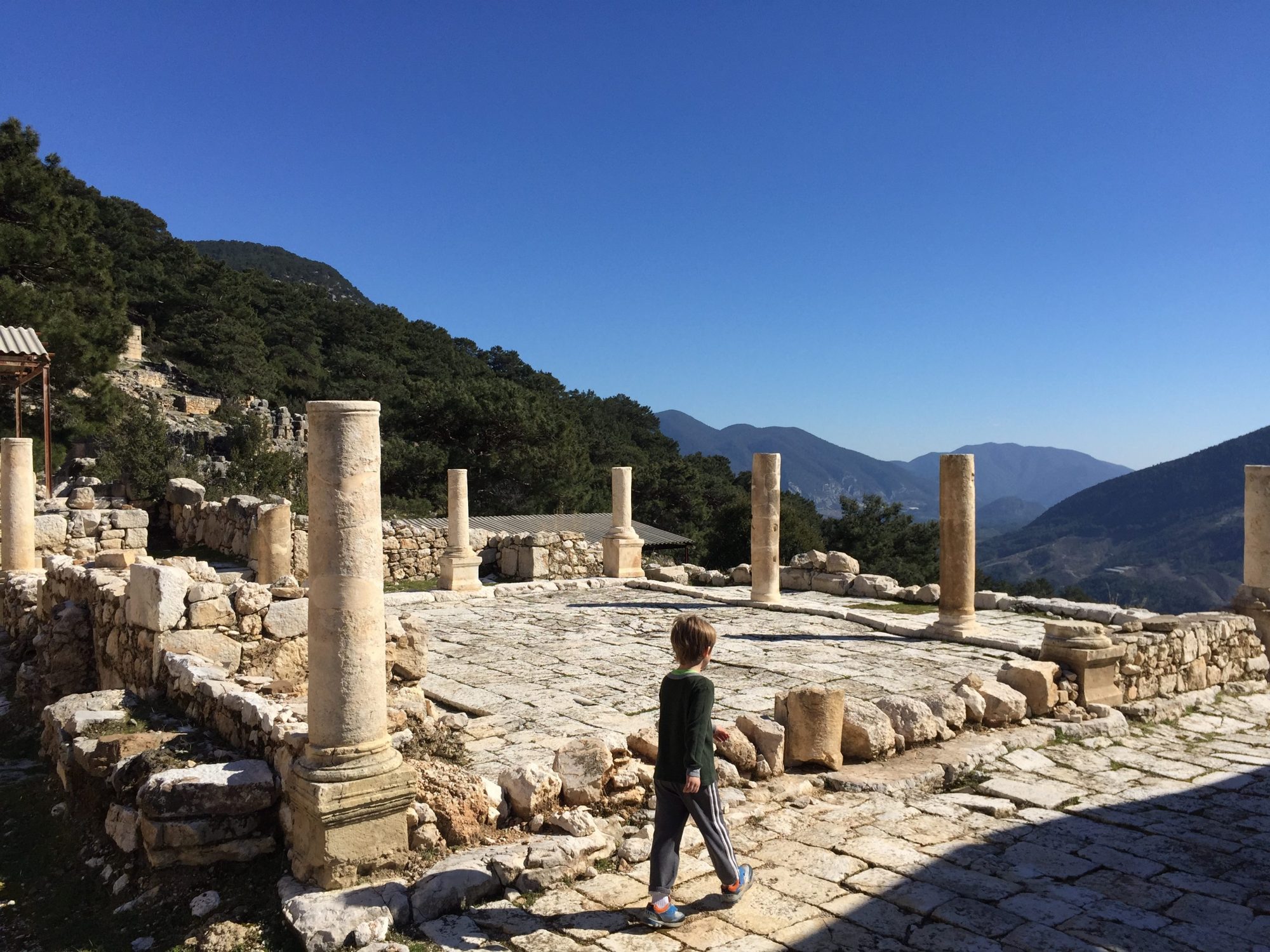
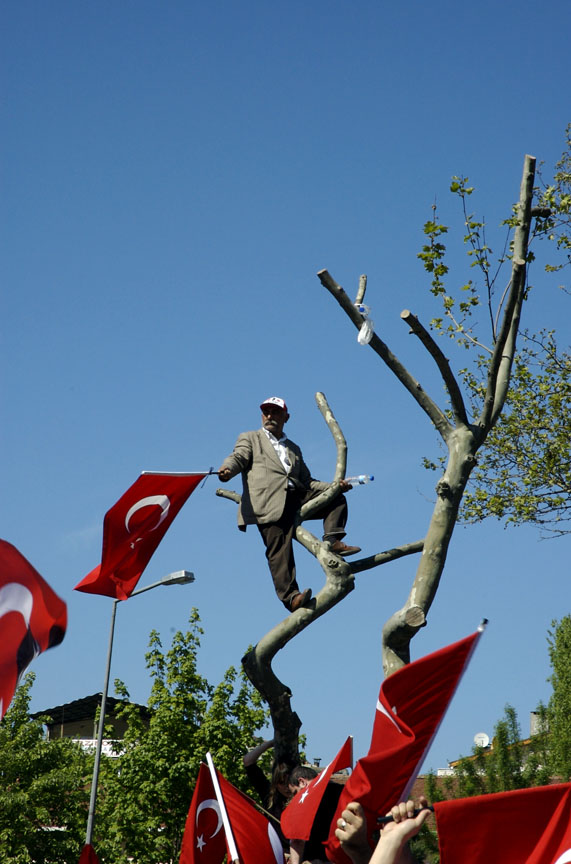
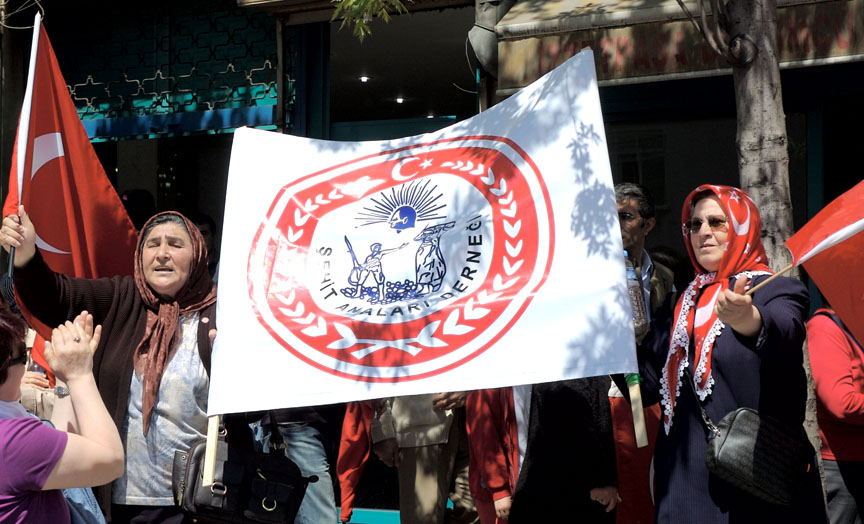
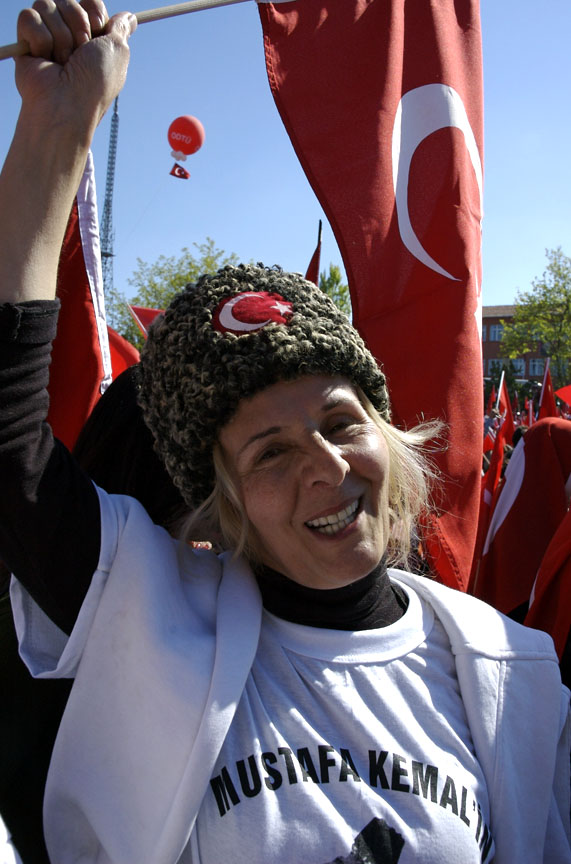
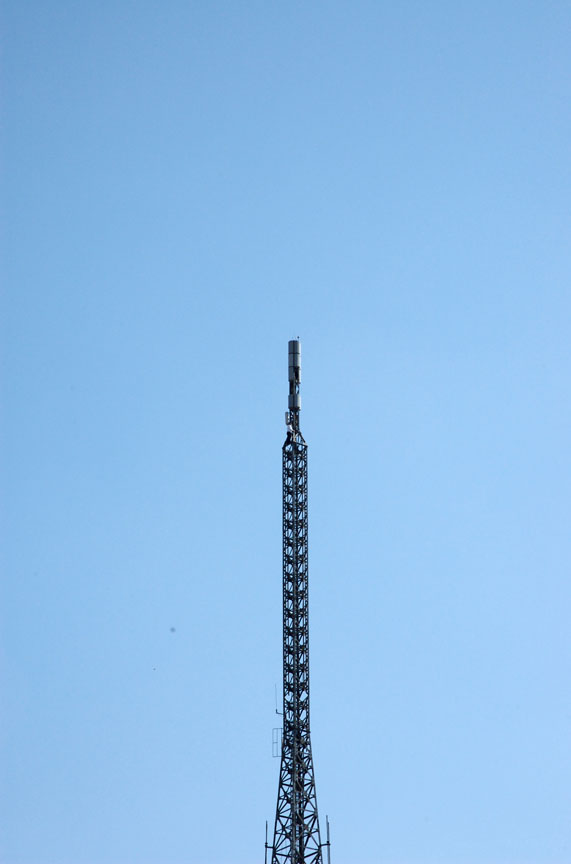
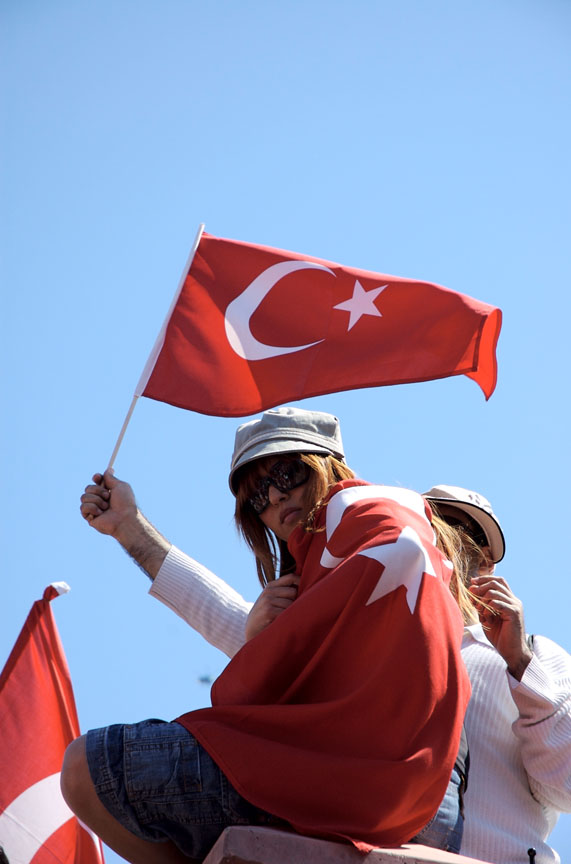
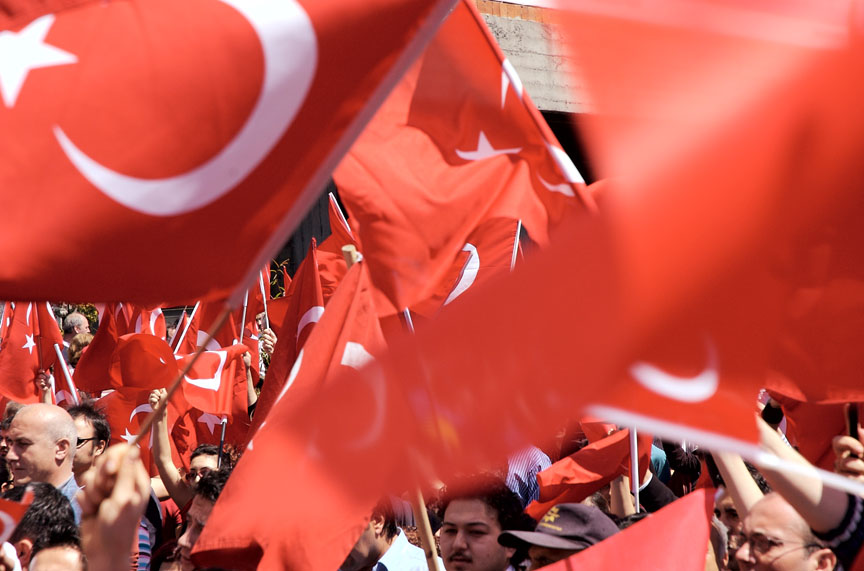
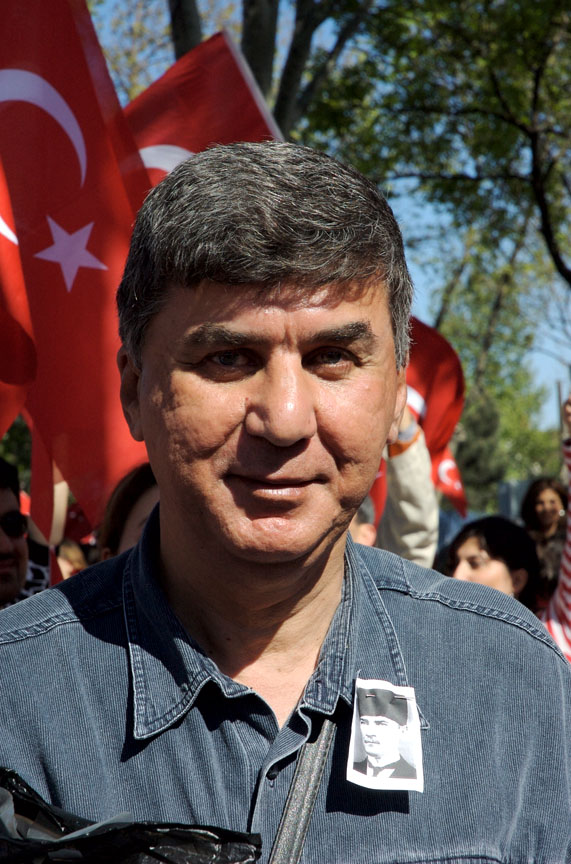

Sercin wrote in to say that imam bayildi is not a dessert, but a main course – and even supplied photographic evidence!
http://www.portakalagaci.com/oburcuk/2004/09/imambayld.html
I did look it up, but apparently should have double-checked my source…
imam bayildi looks really good. I wish I could read the recipe
– there are NINE versions of the dish here:
http://www.aubergines.org/recipes.php?eggplant=1303
45 degrees and perpendicular are mutually exclusive. perpendicular, or normal, is by deffinition 90 degrees.
You and metaphor seem to be mutually exclusive as well…
to rich- dork.